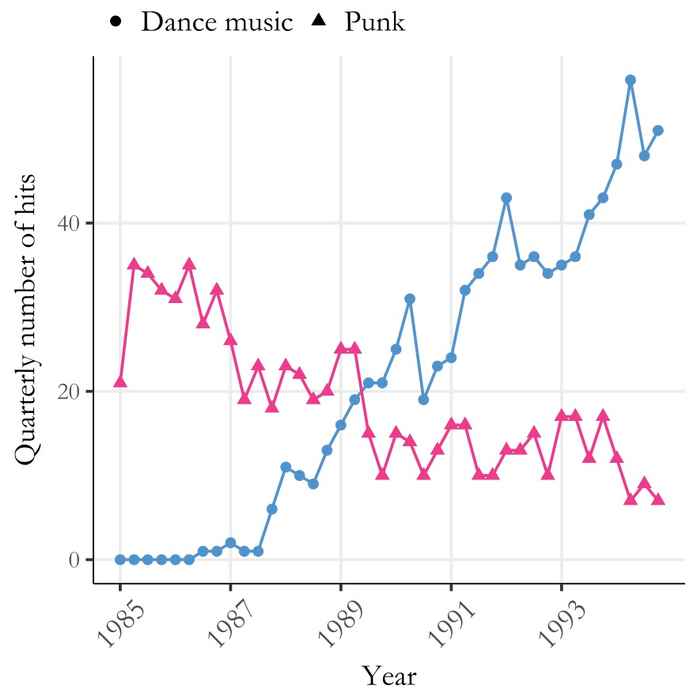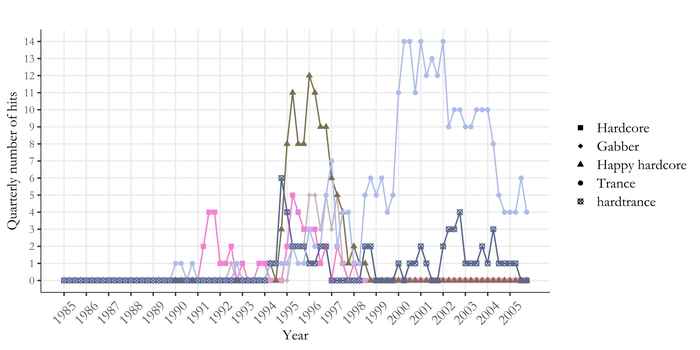Standing on the shoulders of punk: the early years of dance
And why trance in the Netherlands benefited from the demise of hardcore
28 september 2023

In the late 1980s, many dance enthusiasts lived it up every weekend in clubs such as the Roxy in Amsterdam, Shoom in London or the Hacienda in Manchester. House and techno paved the way , other dance genres would soon follow them up the charts. But while the Netherlands and the UK fell in love with dance, its popularity in the US lagged behind. The first mainstream house hit - Love Can't Turn Around by two American producers - was a hit in Europe, but not in the US.
‘I conduct research into the development of new genres in art and culture,’ says Wilderom. 'Dance has a relatively short, but very interesting history. An important factor in a music genre becoming popular is the (decreasing) popularity of related, existing genres within music. In addition, the media and even the government are important for the institutionalisation of a new genre, helping it become a part of society.'
In his research, Wilderom analysed data on the establishment of dance labels, the commercial success of dance records, and reporting by traditional newspapers and the specialised music press, among other things.
From beginnings in the US to mainstream in the UK
Dance music originally comes from the US. In the 1980s, certain disco scenes were experimenting with drum machines. One of those scenes was in Chicago, at a club called The Warehouse (from which house music allegedly takes its name). While early dance genres such as house and techno thrived in these scenes, they did not achieve much in the way of mainstream success.

Wilderom: 'It was different in the UK. The popularity of (post-)punk declined in the early 1980s. However, the infrastructure of punk labels, punk record stores, punk venues was still there. A number of cultural entrepreneurs in the punk scene wanted something new, something that was still 'authentic' and untouched, and they saw this new scene in the US that met that requirement.'
In the UK, people invested in creating value from the new genre. House was seen as the new punk. In its early days, house attracted a large number of people who had previously been active in punk. Influential people within the music field such as BBC Radio DJs were also involved right from the beginning.
'One reason why dance was able to break through in the UK was the proactive search for the undiscovered, and the benefit of having those labels, shops and stages still existing from the days of punk. Switching to a new genre allowed the former (post-)punk-affiliates to survive in the market,' says Wilderom.
Trance benefits from hardcore's downfall
The developments surrounding dance in the UK were probably also important for the rise and popularity of dance in the Netherlands. For example, a significant number of the first dance hits in the Netherlands were released by British record labels such as 4AD and a number of Britons such as Maz Weston and Paul Jay were involved in organising the first dance parties in Amsterdam. Almost from the beginning, dance (then mainly house) was picked up in the Netherlands by mainstream media. This was a marked difference from the US, where that kind of attention was lacking.

'The theory of genres - that the relationship with existing genres and other facets from the environment are important for the development of a new genre - can also be applied within clusters of related genres. Here in the Netherlands, for example, you see that trance could quickly become popular due to the demise of hardcore,' says Wilderom.
'Trance made use of the existing network and infrastructure of hardcore, in a similar way to how house had made use of the punk network. When hardcore declined in popularity, some of the artists, labels and festival organisers converted from hardcore to trance. It is not a coincidence that famous trance DJs such as Ferry Corsten and Tiësto also have a history in hardcore.'
PhD details
Dhr. B.R. Wilderom: 'Genres, Webs of Fields, and Institutional Change: The Development of Dance in the US, UK, and the Netherlands, 1985–2005'. Supervisor is Prof. G.M.M. Kuipers. Co-supervisor is Dr A.T. van Venrooij.